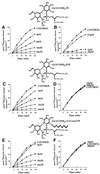Specificity of GlcNAc-PI de-N-acetylase of GPI biosynthesis and synthesis of parasite-specific suicide substrate inhibitors
- PMID: 11432820
- PMCID: PMC125529
- DOI: 10.1093/emboj/20.13.3322
Specificity of GlcNAc-PI de-N-acetylase of GPI biosynthesis and synthesis of parasite-specific suicide substrate inhibitors
Abstract
The substrate specificities of Trypanosoma brucei and human (HeLa) GlcNAc-PI de-N-acetylases were determined using 24 substrate analogues. The results show the following. (i) The de-N-acetylases show little specificity for the lipid moiety of GlcNAc-PI. (ii) The 3'-OH group of the GlcNAc residue is essential for substrate recognition whereas the 6'-OH group is dispensable and the 4'-OH, while not required for recognition, cannot be epimerized or substituted. (iii) The parasite enzyme can act on analogues containing betaGlcNAc or aromatic N-acyl groups, whereas the human enzyme cannot. (iv) Three GlcNR-PI analogues are de-N-acetylase inhibitors, one of which is a suicide inhibitor. (v) The suicide inhibitor most likely forms a carbamate or thiocarbamate ester to an active site hydroxy-amino acid or Cys or residue such that inhibition is reversed by certain nucleophiles. These and previous results were used to design two potent (IC50 = 8 nM) parasite-specific suicide substrate inhibitors. These are potential lead compounds for the development of anti-protozoan parasite drugs.
Figures









Similar articles
-
Differences between the trypanosomal and human GlcNAc-PI de-N-acetylases of glycosylphosphatidylinositol membrane anchor biosynthesis.Glycobiology. 1999 Apr;9(4):415-22. doi: 10.1093/glycob/9.4.415. Glycobiology. 1999. PMID: 10089216
-
Substrate specificity of the Plasmodium falciparum glycosylphosphatidylinositol biosynthetic pathway and inhibition by species-specific suicide substrates.Biochemistry. 2002 Oct 15;41(41):12395-406. doi: 10.1021/bi020351l. Biochemistry. 2002. PMID: 12369829
-
Mammalian PIG-L and its yeast homologue Gpi12p are N-acetylglucosaminylphosphatidylinositol de-N-acetylases essential in glycosylphosphatidylinositol biosynthesis.Biochem J. 1999 Apr 1;339 ( Pt 1)(Pt 1):185-92. Biochem J. 1999. PMID: 10085243 Free PMC article.
-
[The synthesis of specific enzyme inhibitors].Bioorg Khim. 1987 Apr;13(4):437-97. Bioorg Khim. 1987. PMID: 3300658 Review. Russian.
-
Targeting the GPI biosynthetic pathway.Pathog Glob Health. 2018 May;112(3):115-122. doi: 10.1080/20477724.2018.1442764. Epub 2018 Feb 27. Pathog Glob Health. 2018. PMID: 29484956 Free PMC article. Review.
Cited by
-
Chemical validation of GPI biosynthesis as a drug target against African sleeping sickness.EMBO J. 2004 Nov 24;23(23):4701-8. doi: 10.1038/sj.emboj.7600456. Epub 2004 Nov 4. EMBO J. 2004. PMID: 15526036 Free PMC article.
-
Lipid metabolism in Trypanosoma brucei.Mol Biochem Parasitol. 2010 Aug;172(2):66-79. doi: 10.1016/j.molbiopara.2010.04.001. Epub 2010 Apr 9. Mol Biochem Parasitol. 2010. PMID: 20382188 Free PMC article. Review.
-
Inhibitors incorporating zinc-binding groups target the GlcNAc-PI de-N-acetylase in Trypanosoma brucei, the causative agent of African sleeping sickness.Chem Biol Drug Des. 2012 Mar;79(3):270-8. doi: 10.1111/j.1747-0285.2011.01300.x. Chem Biol Drug Des. 2012. PMID: 22222041 Free PMC article.
-
Fragment screening reveals salicylic hydroxamic acid as an inhibitor of Trypanosoma brucei GPI GlcNAc-PI de-N-acetylase.Carbohydr Res. 2014 Mar 31;387(100):54-8. doi: 10.1016/j.carres.2013.12.016. Epub 2013 Dec 30. Carbohydr Res. 2014. PMID: 24589444 Free PMC article.
-
Identification and functional analysis of Trypanosoma cruzi genes that encode proteins of the glycosylphosphatidylinositol biosynthetic pathway.PLoS Negl Trop Dis. 2013 Aug 8;7(8):e2369. doi: 10.1371/journal.pntd.0002369. eCollection 2013. PLoS Negl Trop Dis. 2013. PMID: 23951384 Free PMC article.
References
-
- Borissow C.N., Smith,T.K., Ferguson,M.A.J. and Brimacombe,J.S. (2001) Synthesis of 3′-, 4′- and 6′-deoxy and other analogues of d-glucosaminylphosphatidylinositol. Tetrahedron Lett., 42, 121–123.
-
- Cottaz S., Brimacombe,J.S. and Ferguson,M.A.J. (1993) Parasite glycoconjugates. Part 1. Synthesis of some early and related inter mediates in the biosynthetic pathway of glycosyl-phosphatidylinositol membrane anchors. J. Chem. Soc. Perkin Trans., 1, 2945–2951.
-
- Cross G.A.M. (1996) Antigenic variation in trypanosomes: secrets surface slowly. BioEssays, 18, 283–291. - PubMed
-
- Crossman A., Brimacombe,J.S. and Ferguson,M.A.J. (1997) Parasite glycoconjugates. Part 7. Synthesis of further substrate analogues of early intermediates in the biosynthetic pathway of glycosyl phosphatidylinositol membrane anchors. J. Chem. Soc. Perkin Trans., 1, 2769–2774.
Publication types
MeSH terms
Substances
LinkOut - more resources
Full Text Sources
Other Literature Sources
Research Materials
Miscellaneous

